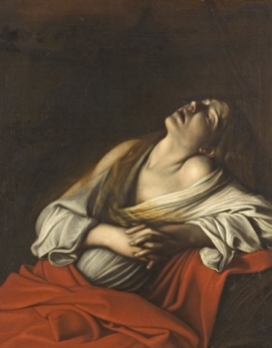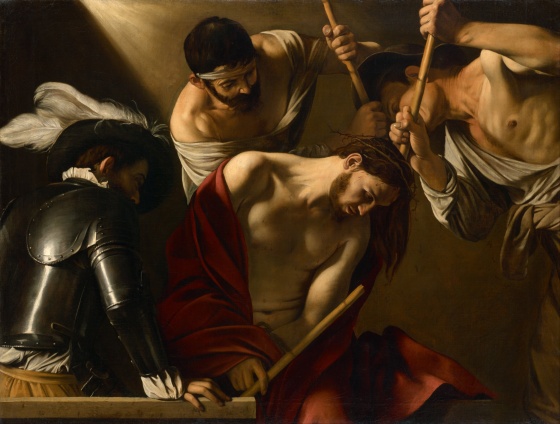I was invited to a press preview in the exquisite Willem V Gallery in The Hague on the occasion of the loan of the National Gallery’s Boy bitten by a Lizard by Michelangelo Merisi da Caravaggio (1595/1600). The Willem V Gallery is a branch of the Mauritshuis Museum which is currently closed due to renovations. The first museum to open to the general public in The Netherlands it was created by the last Stadtholder, Willem V, and opened in 1774. It closed its doors in 1822 when he collection was moved to the Mauritshuis. Recently reopened after restoration the Gallery presents an attractive arrangement of paintings reflecting the artistic tastes of Willem V in an attractive and intimate setting.
The Boy bitten by a Lizard is currently the only Caravaggio in the Netherlands and that only temporarily. The last time we had Caravaggios here was during the Rembrandt-Caravaggio blockbuster exhibition in 2006. Dutch Caravaggism in 17th century Netherlandish art is connected with the Utrecht Caravaggists mostly who, returning from Italy, fashioned their own brand of Caravaggism. But is there evidence of the presence of Caravaggio paintings themselves?
A crucial figure in this respect is the painter Louis Finson or, as he often signed himself: Ludovicus Finsonius, also known as Louis Vinson. Born in Bruges not long before 1580, Finson traveled to Italy where he is recorded in Naples in 1604. The journey would have included Rome where he was probably one of the young artists impressed with the innovative art he saw such as the Contarelli Chapel paintings by Caravaggio. We know from Nicolas-Claude Fabri de Peiresc, who knew him especially in Provence, that Finson was closely involved with Caravaggio: “Il a toute la manière de Michel Angelo Caravaggio et s’est nourry longtemps avec luy” (he paints entirely in the style of Michel Angelo [da] Caravaggio en has been nourished by him for a long time).
Finson was among the first artists to realise the potential profit that could be gained from introducing Caravaggio’s new naturalism and revolutionary technique wherever he went. He had come to possess several paintings by Caravaggio, including the Penitent Magdalene painted at Zagarola where Caravaggio had taken refuge after fleeing Rome. Finson painted one, possibly several, copies of this painting after his return to the north; one is recorded in the 1696 inventory of Geertruijdt Delff, widow of Jacob van Campen (not the architect), as: Een dito [schilderij] van Maria Magdalena gedaen door Lodovicus Vinsonius (a painting of Mary Magdalene done by Louis Finson).
The copy shown above right is signed and shows a personal touch: Finson added a skull under Mary Magdelene’s left elbow. The signature on the cartellino makes it clear that Finson intended to pass the painting as his own original work without mention of Caravaggio as inventor.
In Northern collections, for instance that of the very wealthy Rotterdam brewer Reynier van der Wolf whose collection included works by Titian, Giorgione, Dosso Dossi, Anibale Caracci and Bassano, another copy of Caravaggio’s Penitent Magdalene is found, described in the 1687 inventory as “a dying Magdalene, very natural, a powerful work, and extraordinary, by Michael Angelo da Caravaggio”. I cannot stress enough the benefit of photography and the Internet which today makes attributions, while still hazardous, so much easier: it is quite possible that the unsuspecting Van der Wolf owned not a Caravaggio but an unsigned copy, possibly by Finson, passing as one.
Arriving in Amsterdam in 1617, Finson moved in with Abraham Vinck or Vincx, a fellow painter he had met in Naples as early as 1605. Vinck had married a Neapolitan woman and had settled with her in Amsterdam in 1610. He too had been close to Caravaggio: a 17th century source calls him amicissimo di Caravaggio (a very close friend of Caravaggio). After a protracted illness Finson died in Vinck’s house on the corner of the Oude Doelenstraat and the Oudezijds Voorburgwal in late September 1617. On 1 October he was buried in Amsterdam’s Oude Kerk (Old Church). Several weeks before his death he had dictated his will from which it appears that he and Vinck co-owned two paintings by Caravaggio, The Madonna of the Rosary and a Judith with the head of Holofernes (now lost).
Finson bequeathed to Vinck his half-ownership of the two paintings. He owned a third painting by Caravaggio, The Crucifixion of St Andrew, while Vinck owned yet another, unnamed, painting by the Italian master valued at 600 guilders which at the time of his death in 1619 was still in Rome. After Vinck’s death, the Madonna of the Rosary passed into the hands of a consortium of painters among whom Rubens and Jan Brueghel who donated the painting to the Dominican convent in Antwerp where it still hung in 1636.
By the time Pieter Lastman (1583-1633), Rembrandt’s teacher in 1625, was asked, in 1619, to authenticate the Crucifixion of St Andrew, the three Amsterdam painters who had lived and worked in Naples, Finson, Vinck and Centen, had died and now Lastman with his Italian background was called upon as Caravaggio expert. Apart from Lastman, the group of painters who had been asked to authenticate the painting consisted of Barent van Someren, Willem van den Bundel, Adriaen van Nieulandt and Louis du Pret, none of whom had been to Italy. All declared unanimously that the Crucifixion was “a principal piece of the great master Caravaggio”, which was probably not true since the original hung in Valladolid in Spain at the time. It is interesting in this respect that the authenticity of the Cleveland Crucifixion of St Andrew, until now considered to be the original, has been questioned.
In 1630 Pieter Lastman was once more asked to authenticate a painting, this time a copy of the Madonna of the Rosary by Finson where the intention seems to have been to certify that the painting was indeed a copy and not the original.
Doubts about the authenticity of Caravaggio’s paintings were not unfounded because both Louis Finson and Abraham Vinck had been excellent copyists of that master’s works. It has recently been pointed out that Caravaggio’s Crowning with Thorns looks rather flat but that the work is unmistakably Caravaggesque. Possibly parts of the painting were executed by other artists, and it is tempting to think of either Vinck or Finson in this respect.
Why did paintings of such importance as Caravaggio’s Madonna of the Rosary, with which so many painters were involved, leave so few traces in the Dutch and specifically the Amsterdam art scene? It seems that several painters, such as Lastman, borrowed only fragmentary elements but then his ambition was centred on narrative history paintings of a relatively small format, for which he was more indebted to two northern painters living and working in Rome, Adam Elsheimer and Paul Brill, as well as on his meticulous study of Roman antiquity.
We find some traces of Caravaggio’s Madonna of the Rosary in Lastman’s Odysseus and Nausikaä (1619) in Munich, in which the pyramidal composition of the central figures and the chiaroscuro betray its influence while Odysseus’ bare feet seem to be directly derived from Caravaggio’s painting. Caravaggio’s influence is even more obvious in Lastman’s Saints Paul and Barnabas in Lystra (1617) where the right half of the composition follows that of the Madonna of the Rosary closely. The 1617 Paul and Barnabas can be said to be an important turning point in Lastman’s oeuvre. Until then his crowded narrative scenes had shown a horizontal orientation, rather like an antique frieze, whereas from 1617 onwards his compositions became more vertical.
It was not so much Caravaggio himself as some Caravaggesque motifs derived from Lastman and others that influenced Rembrandt and others, rather: that they used them in their own inventions. Even more importantly, and a neglected influence, are the many paintings by Italian Caravaggio followers, such as Bartolommeo Manfredi (1582-1622) whose works are known to have been in important Amsterdam collections Rembrandt must have known. When one of these collections, that of the wealthy merchant Balthasar Coymans (1555-1634), was sold in 1709, the inventory lists, next to several paintings by Manfredi, no less than three paintings by none other than Caravaggio (3 van M. Angelo de Caravaggio). Which could just bring us back to the Caravaggio copyists Finson and Vinck.
Note:
- Abraham Bredius, Iets over de schilders, Louys, David en Pieter Finson, Oud Holland 36, 1918;
- D. Bodart, Louis Finson, Brussels, 1970.













